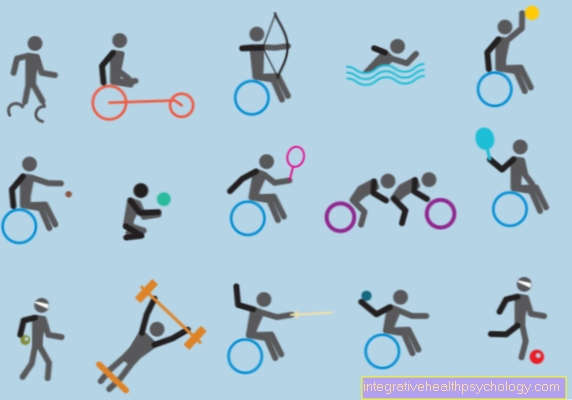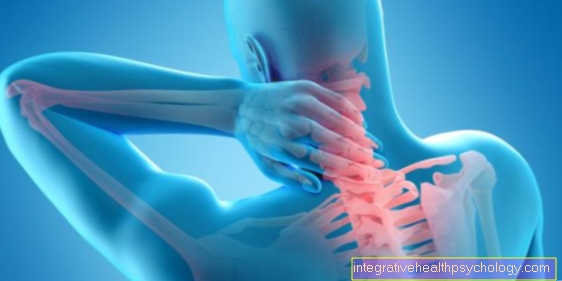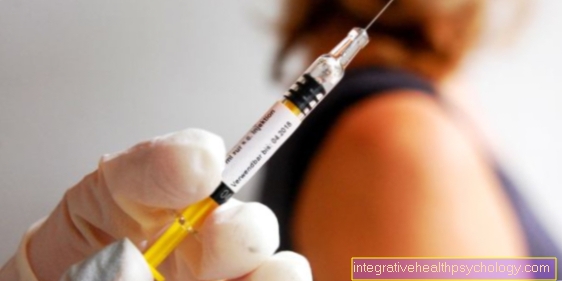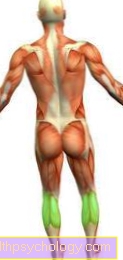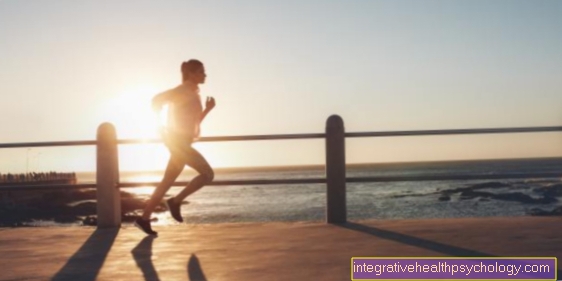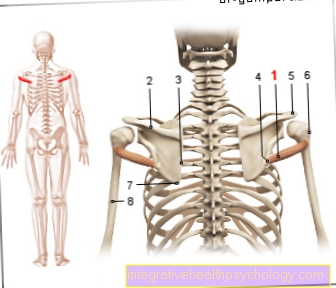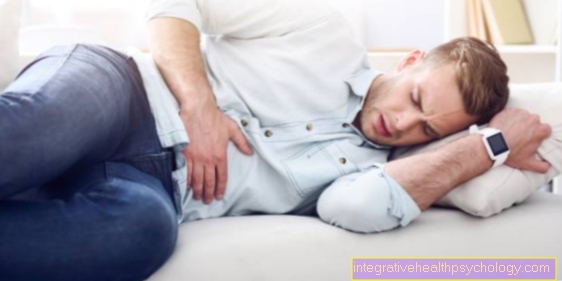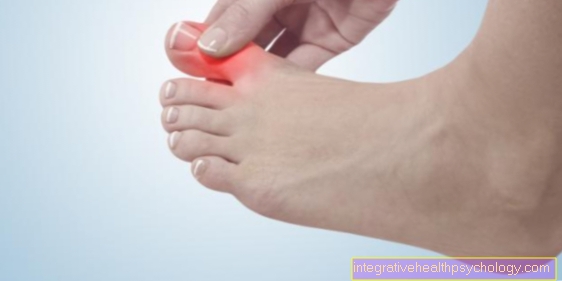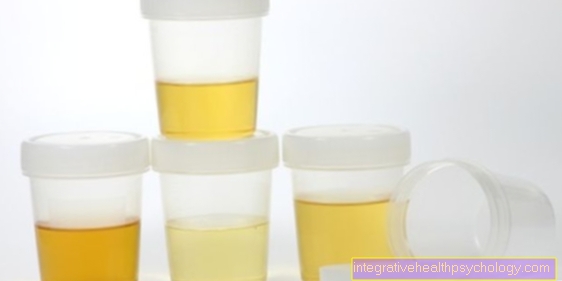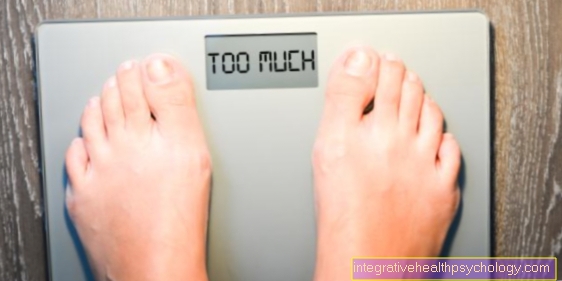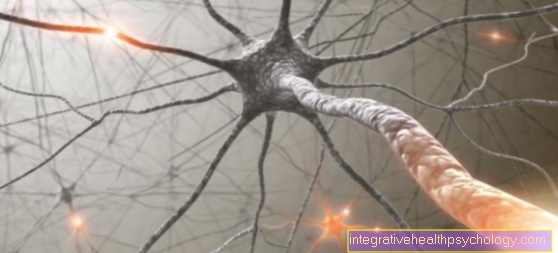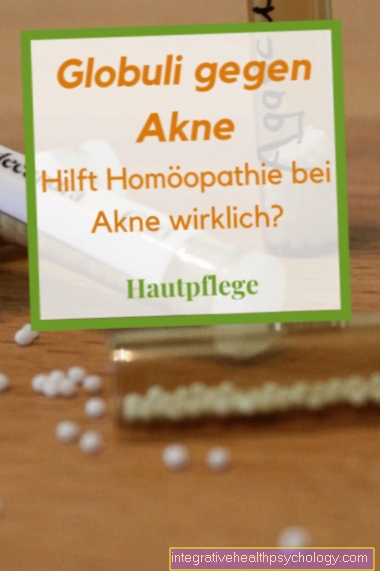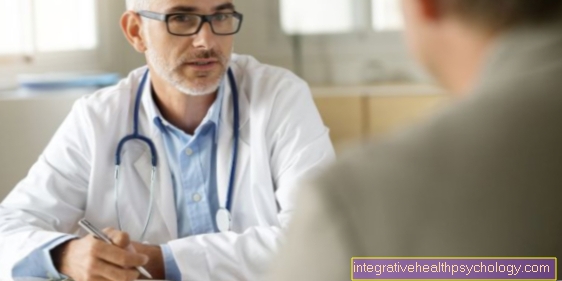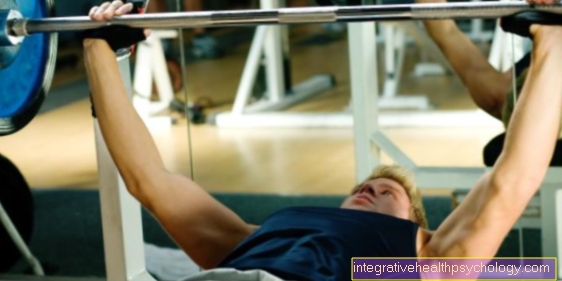Stroke of the cerebellum
introduction
A stroke is a disease that occurs as a result of a blood flow disorder in the brain. All areas of the brain have to be supplied with blood through arteries. Therefore, not only the so-called cerebrum (Cerebrum) be affected by a stroke, but also other areas of the brain such as the brain stem or cerebellum (Cerebellum). The cerebellum is located in the lower, rear area of the skull and is responsible for tasks such as coordination and interaction of movement sequences, balance and also for eye movements. These functions can be impaired if a stroke occurs in the cerebellum. The classic symptoms of a stroke such as unilateral paralysis and sensitivity disorders or certain language disorders are therefore not to be expected in the event of a stroke in the cerebellum.

These symptoms indicate a stroke in the cerebellum
A stroke occurs suddenly. This means that the symptoms appear suddenly even in the event of a stroke in the cerebellum. Symptoms that develop over a long period of time (days or weeks) are not typical of a stroke.
Symptoms that can occur in the cerebellum after a stroke are disorders in the movement sequences and muscle tension. It can lead to an impairment of the upright sitting or the upright posture (Trunk ataxia) or to disturbances when walking (Gait ataxia), typical are an unsteady gait pattern with legs wide apart (broad-based gait pattern). In addition, disturbances in movement sequences can occur that require rapidly changing movements, such as screwing in a lightbulb (Dysdiadochokinesis). Balance disorders can also occur as part of a stroke in the cerebellum and manifest as falls and dizziness. Furthermore, disturbances can occur in targeted movements of the arms and hands, the so-called Intention tremor. When picking up or grasping an object, e.g. If you try to touch the tip of your nose with your index finger, you may fail to touch the tip of your nose. Furthermore, disturbances of the eye movements can occur, e.g.can express themselves through the appearance of double vision. There may also be a rhythmic twitching or trembling of the eyes, this phenomenon is called nystagmus. The muscular movements when speaking can be affected. This manifests itself in a speech disorder (not speech disorder), whereby the affected person has difficulty speaking clearly (similar to drunk people).
These symptoms can appear individually or together. Headaches can also occur after a stroke of the cerebellum. In the context of accompanying strokes in the brain stem or the occurrence of brain edema, impaired consciousness can be the result.
Further information on this topic can be found at: Cerebellar damage and signs of stroke
You might also be interested in: This is how a stroke is diagnosed
Balance disorder
Because the cerebellum is involved in the regulation of balance. A functional impairment in the cerebellum can lead to balance disorders. These can be noticeable when walking and standing or cause dizziness. In the case of a stroke of the cerebellum, such imbalances occur very suddenly.
dizziness
Dizziness can occur as a result of a stroke to the cerebellum. The impairment of the equilibrium system can lead to dizziness, which may be accompanied by nausea and vomiting.
Also read our topic: Dizziness after a stroke
These are the long-term consequences
In the best possible case, the symptoms of the stroke regress completely. Often, the inpatient treatment is followed by neurological rehabilitation. Physiotherapy and other supportive measures are available there for those affected.
Unfortunately, however, it is not always the case that all symptoms regress. After a stroke, there is a possibility that brain tissue has perished. Therefore, there is a possibility that the symptoms that arose during a cerebellar stroke may remain permanent.
In the course of a cerebellar infarction, brain swelling can develop within hours to days (Brain edema) come. This is particularly dangerous in the area of the cerebellum and can lead to a narrowing of the brain stem due to increased intracranial pressure. If left untreated, this is a life-threatening condition. A stay in an intensive care unit is therefore necessary. In this case, cerebral edema is caused by draining cerebral fluid from the skull (Ventricular drainage) or, if the brainstem threatens to narrow, with an opening of the cranial bone (Craniotomy) so that the pressure is reduced again.
This is the cure for a cerebellar stroke
A stroke in the cerebellum is primarily treated no differently from a stroke in other areas of the brain. After admission, examination, blood collection and imaging of the person in the emergency room, further treatment takes place. If the person concerned comes to the neurological emergency room within 4.5 hours of the onset of symptoms, special stroke therapy, known as lysis therapy, can take place. Depending on the body weight of the person concerned, a certain blood thinner (rt-PA) is injected into the vein. If the person concerned arrives later than 4.5 hours after the onset of the symptoms, if there are contraindications or if the symptoms have completely disappeared, the person concerned no longer benefits from this treatment. Then basic therapy of the stroke is carried out. This includes thrombosis prophylaxis (mostly in the form of abdominal injections), adjustment of electrolytes, blood sugar, blood pressure and body temperature.
In addition, platelet aggregation inhibitors such as e.g. ASA or clopidogrel and drugs to lower blood lipids such as Prescribed statins.
It is also important to determine the cause of a stroke in the cerebellum when healing. Therefore, various examinations are carried out in inpatient treatment. The heart is examined and the blood vessels, and various blood tests are usually carried out. The causes of a stroke can often be traced back to a rhythm disturbance in the heart (atrial fibrillation) or to vascular changes such as arteriosclerosis.
You might also be interested in these topics: Healing after a stroke
You can do this yourself to improve healing
In order to improve healing, it is important to follow the guidelines of the doctors. The prescribed therapy recommendations regarding medication and lifestyle should be carried out urgently. It is important to have good blood sugar levels (if you have diabetes) and blood pressure. If the person concerned is a smoker, they should urgently give up smoking. If you are overweight or obese, your body weight should be reduced. A general recommendation is that the diet should conform to the Mediterranean style (lots of fruit and vegetables, fish) and exercise at least 3 times 30 minutes per week. In neurological rehab, the physiotherapy and speech therapy exercises should be carried out conscientiously, even if it is difficult at first.


